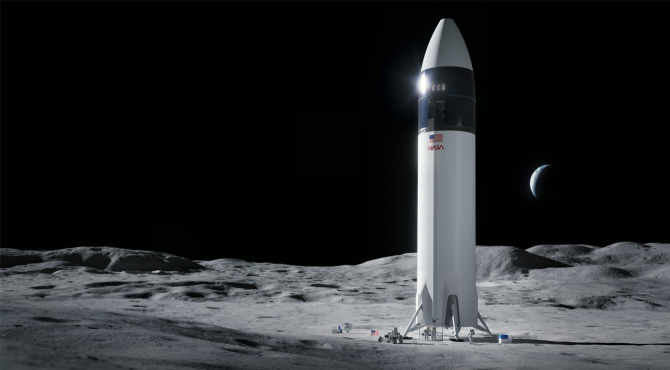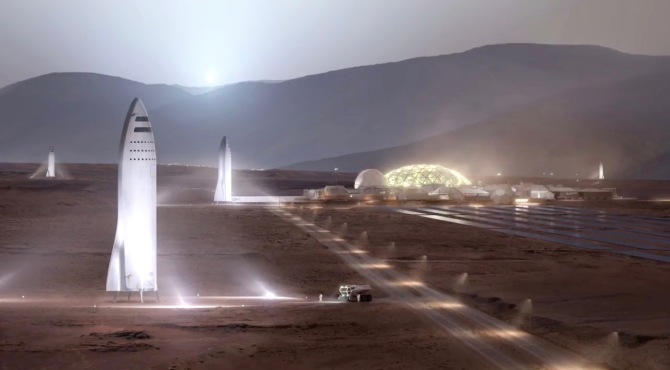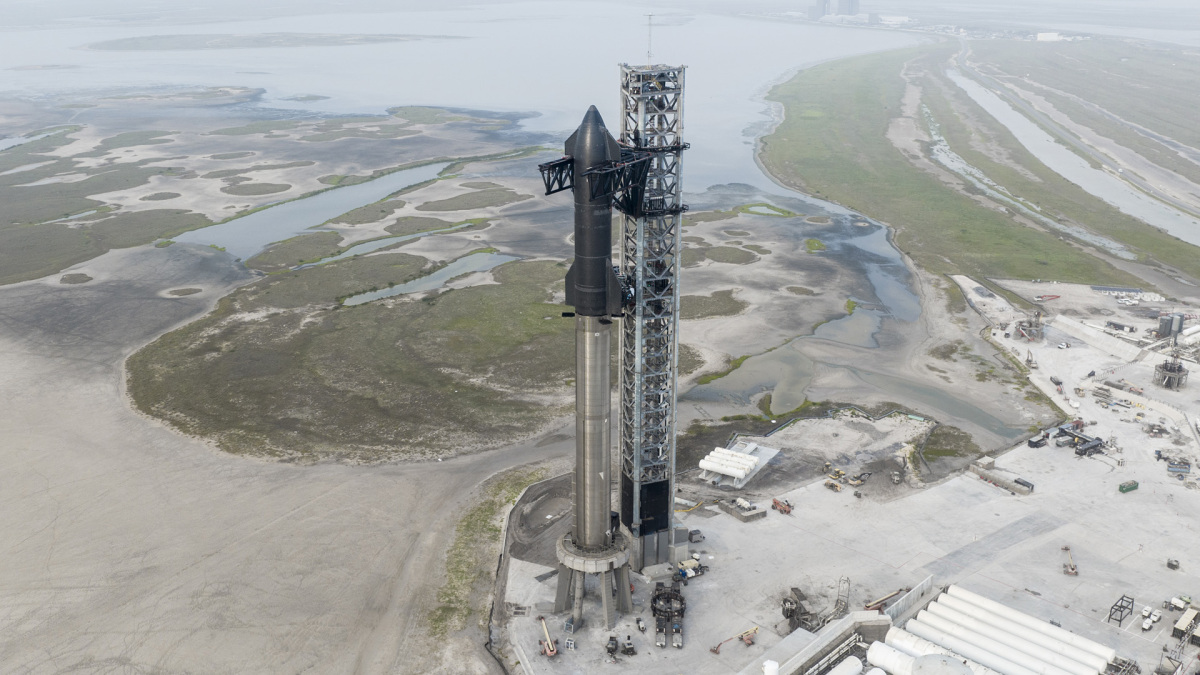[ad_1]
SpaceX launched itself into the public consciousness with the Falcon 9, a highly reliable rocket that has now completed numerous trips to the International Space Station. NASA has even authorized the Falcon 9 and its Dragon capsule to transport astronauts, a first for private aerospace. The Falcon 9 was also the first rocket to perfect propulsive landing, but it’s not a very big vehicle. To reach distant, exotic locales like Mars and the far side of the moon, you need something with a little more oomph. That’s the SpaceX Starship. SpaceX’s mega-rocket is still in development, but it already has some missions lined up, ranging from history-making to silly.
What Is Starship?
The vessel we currently refer to as “Starship” used to be known as the BFR (Big Falcon Rocket) and ITS (Interplanetary Transport System). Along with the name change, SpaceX clarified its vision for moving all its operations to the Starship platform… someday. At its most basic, Starship is a super-heavy lift rocket that can transport large payloads to space. The “Starship” is actually the second stage of a two-stage vehicle to do just that. Starship is the important part with all the cargo and crew inside, but it’s stacked on a first stage known as the “Super Heavy.” SpaceX stacked the two stages for the first time in the summer of 2021 and launched the full stack in April 2023. While the rocket cleared the tower, it entered a tumble before separating from the first stage and had to be remotely destroyed.
SpaceX says Super Heavy is necessary to get the spacecraft out of Earth’s gravity well with enough fuel to get where it’s going. Starship can then travel to its destination (like Mars), and then launch itself back into space without Super Heavy thanks to the lower gravity. Starship is fully reusable, but the jury is still out on the Super Heavy component. SpaceX has gotten good at landing Falcon 9 boosters, but this rocket is comparatively enormous. CEO Elon Musk has said the company plans to try catching Super Heavy with a launch tower, but that doesn’t sound easy even for the company that built the Falcon 9.
Starship, without Super Heavy, is 160 feet tall (50 meters) and has a diameter of 30 feet (9 meters). That makes it significantly roomier than the Falcon 9, which is 12 feet in diameter. Dragon, which corresponds to the “Starship” part of Starship, is 20 feet (6.1 meters) tall. Starship sports six 3D-printed Raptor engines, giving it 5,550 kN of thrust. Three of the engines are designed for sea-level use, and the other three are for use in a vacuum. They use subcooled liquid methane and liquid oxygen propellant.
Meanwhile, Super Heavy has a whopping 33 Raptor engines. These are all sea-level variants, giving the stacked rocket a total liftoff thrust of 74,000 kN. NASA’s Space Launch System has 39,000 kN of thrust. When stacked together, Starship and Super Heavy clock in at 394 feet tall (120 meters), making it the largest rocket ever built.
What Will Starship Be Used For?
The upshot of building a bigger rocket is pretty straightforward: heavier payloads and greater range. When it’s done, Starship might be able to wrestle up to 250 tons into low-Earth orbit in an expendable configuration or 150 tons with vehicle recovery. SpaceX is also working on orbital refueling to extend the range.
CEO Elon Musk has been talking about Mars missions since Starship was the BFR, but that’s not the only use case. The first Starship launches will most likely focus on operations in Earth orbit and the moon. One of the first should be the “dearMoon” orbital moon mission, paid for in part by Japanese billionaire Yusaka Maezawa. Officially, SpaceX will send Maezawa and his hand-picked fellow passengers into space in 2023, but that date is starting to look unlikely.
SpaceX will use the Starship to deploy larger swarms of Starlink internet satellites. Currently, the Falcon 9 can take 60 of the micro-satellites into orbit at a time, but the true V2 satellites are much larger and will require Starship. SpaceX has gotten FCC approval to launch up to 7,500 of those internet nodes, and it has already sent a few “mini” versions up with a Falcon 9.
Astronomers are still concerned about how a megaconstellation like Starlink will change the sky, but the economics of space are changing so rapidly that police objects are getting steamrolled. When complete, the cost to launch Starship might be as little as $2 million. That would make SpaceX’s constellation deployment vastly cheaper than any of the competition. In the same vein, it will be able to take large commercial payloads into space, possibly for much less cash than non-reusable rockets.

Credit: SpaceX
NASA is interested in Starship, too. The agency has tapped SpaceX to provide the Human Landing System (HLS) for its upcoming Artemis moon missions. The timeline for these missions is still unclear as it relies on the Space Launch System (SLS), which finally flew the uncrewed Artemis I mission in late 2022. Artemis II is currently slated for late 2024, but SLS timelines have a way of slipping. The idea is that the Starship HLS will meet up with the Orion capsule in lunar orbit, where the crew will transfer to SpaceX’s vehicle. It will descend to the moon and bring astronauts back to orbit once surface operations are complete.
It hasn’t been a focus of SpaceX’s public events lately, but Musk has spoken at length about his hope that Starship could eventually offer rapid transportation around the globe. With the rocket’s anticipated ability to launch and land vertically, it could theoretically reach any location on the globe in about an hour. However, that would include a lot of hard acceleration, making the trip quite uncomfortable. We don’t know yet if this application would require the Super Heavy first stage. If it does, that would limit the locations SpaceX could launch and land the vehicle. The damage to SpaceX’s Boca Chica facility from the first Starship launch was extreme.
When Can You Hitch a Ride to Mars?
Elon Musk has made a lot of predictions about Mars, including that we could have the beginnings of a human colony this decade. Musk envisions a fleet of more than 100 Starships, gathering in orbit of Earth to depart en masse for Mars every 26 months when the planet is closest. Each of them could supposedly carry 100 passengers. Even with the rapid pace of development at SpaceX’s Boca Chica facility, that seems unlikely to happen soon.

Credit: SpaceX
While SpaceX is framing the inaugural orbital test as a success, that position would be more believable if Starship actually made it to orbit. Still, there’s no doubt that simply getting Starship and Super Heavy into the air is a major accomplishment. At almost 400 feet tall, it’s like watching a 25-story building leap into the air on a column of smoke and fire. It’s just nowhere near ready for a human crew.
According to the most recent estimates from SpaceX, the earliest potential flight to Mars (without a crew) would be in 2024, but that is around the same time SpaceX will be working to ready the Artemis HLS. The delays stemming from the April 2023 vehicle loss make a 2024 Mars launch even less likely. It would not be surprising to see Mars take a backseat to more immediate concerns. After all, the health effects of a Mars mission are still unclear, but it doesn’t look promising for colonization.
[ad_2]
Source link

